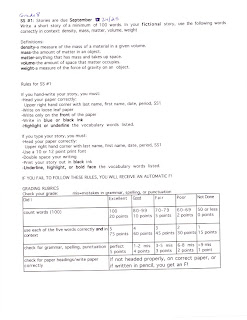 |
| This is HL 7. Answers only on a correctly labeled page. |
 |
| This is HL 8. Answers only on a correctly labeled page. |
|
 |
| This is HL 9. Answers only on a correctly labeled page. |
|
Students will be able to:
-differentiate between physical and chemical properties.
-differentiate between physical and chemical changes.
Students completed the following bell ringer:
Juanita fills
ice trays with water and places the trays in the freezer and closes the freezer
door. What direction does the thermal energy flow?
A. from the water to the outside air.
B. from the freezer to the outside air.
C. from the air in the freezer to the water.
D. from the water to the air in the freezer.
Students received home learnings 7, 8, and 9. Each should be answered on a separate sheet of loose leaf paper, correctly headed. Place answers only on the paper. Do NOT copy the statements. Read and follow the directions. You can find the handouts at the top of this blog. All home learning pages (3) are due next class meeting.
In addition, if you have not submitted, Short Story 1, it is due on Thursday.
Students completed the data chat information on pages 5 and 6 of their notebooks, filling in the FCAT Reading information, the Science baseline assessment information, and the Science Mini-assessment one information.
Students then took notes on Physical and Chemical Properties. Be sure you've recorded the date, (9/24 or 9/25), the benchmark (SC.8.P.8.4), the topic, (Physical and Chemical Properties), and page number (immediately following the lab Chemical Change In A Bag), in your table of contents.
On the page you will be using, be sure to put the date and topic. Then, draw a Cornell notes page. Make a KWL chart, completing the K and W on what you know and would like to know about physical and chemical properties and changes. Use the bottom half of the page to draw something to represent what you know and want to know.
Students then took notes from chapter 8, sections 2 and 3 by making a flip-flap booklet. Fold a sheet of unlined paper in half hamburger style. Fold it again hamburger style. Fold it a third time hot-dog style. Then, open the paper. Cut the three folded lines on the left side of the page, but only up to the middle fold. There are four words to write the definitions and examples: physical property, chemical property, physical change, and chemical change. Be sure to write the word on the outside flap. Write the definition on the uncut inside flap. Draw a picture on the inside cut flat to represent the word. Drawings should be in color. Paste the completed handout on the page AFTER the KWL/Cornell Notes page.
Be sure to complete the 3 Costa's leveled questions, WITH color and the summary on the bottom of the page where the KWL chart is. Also, complete the KWL chart.







